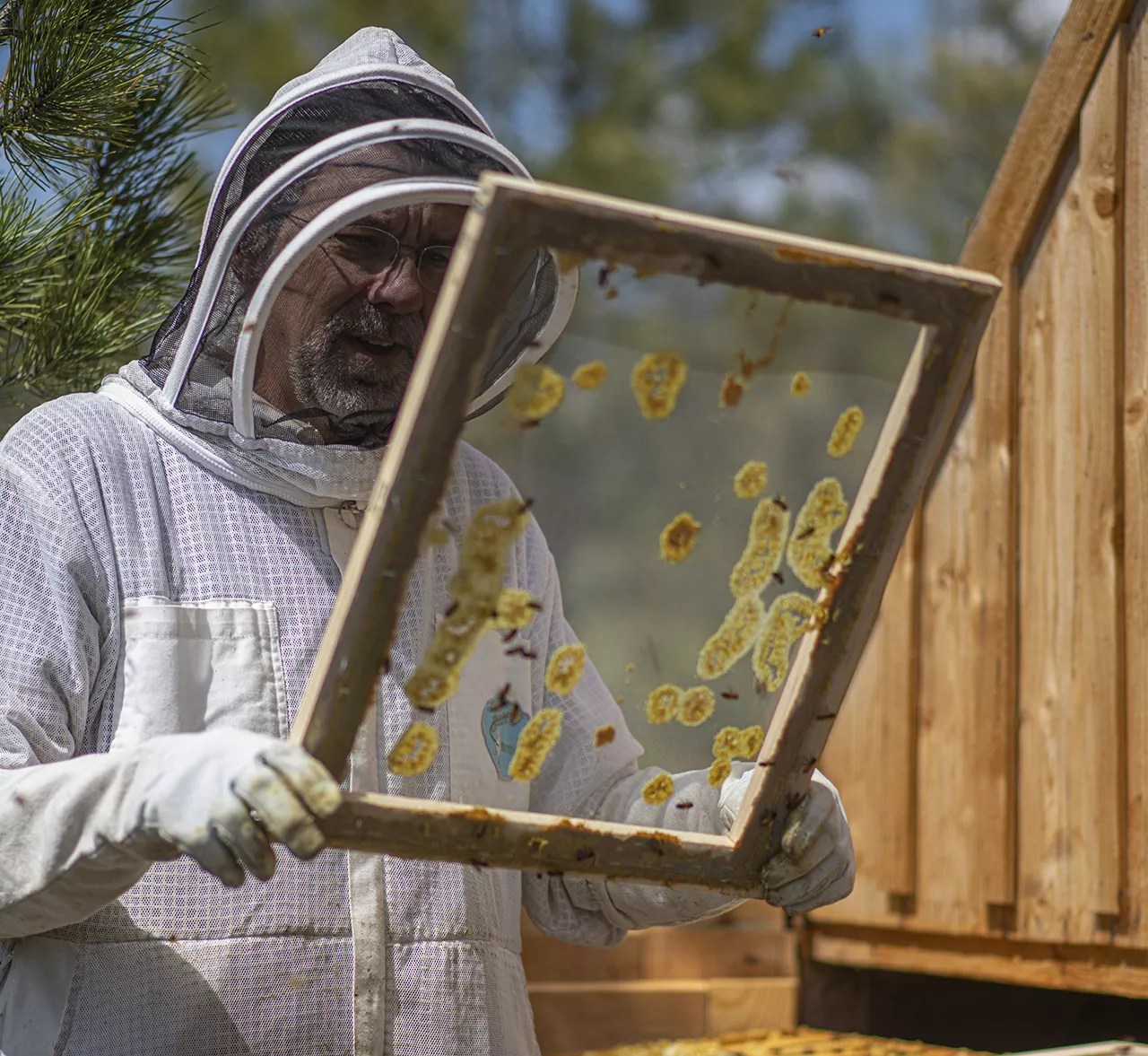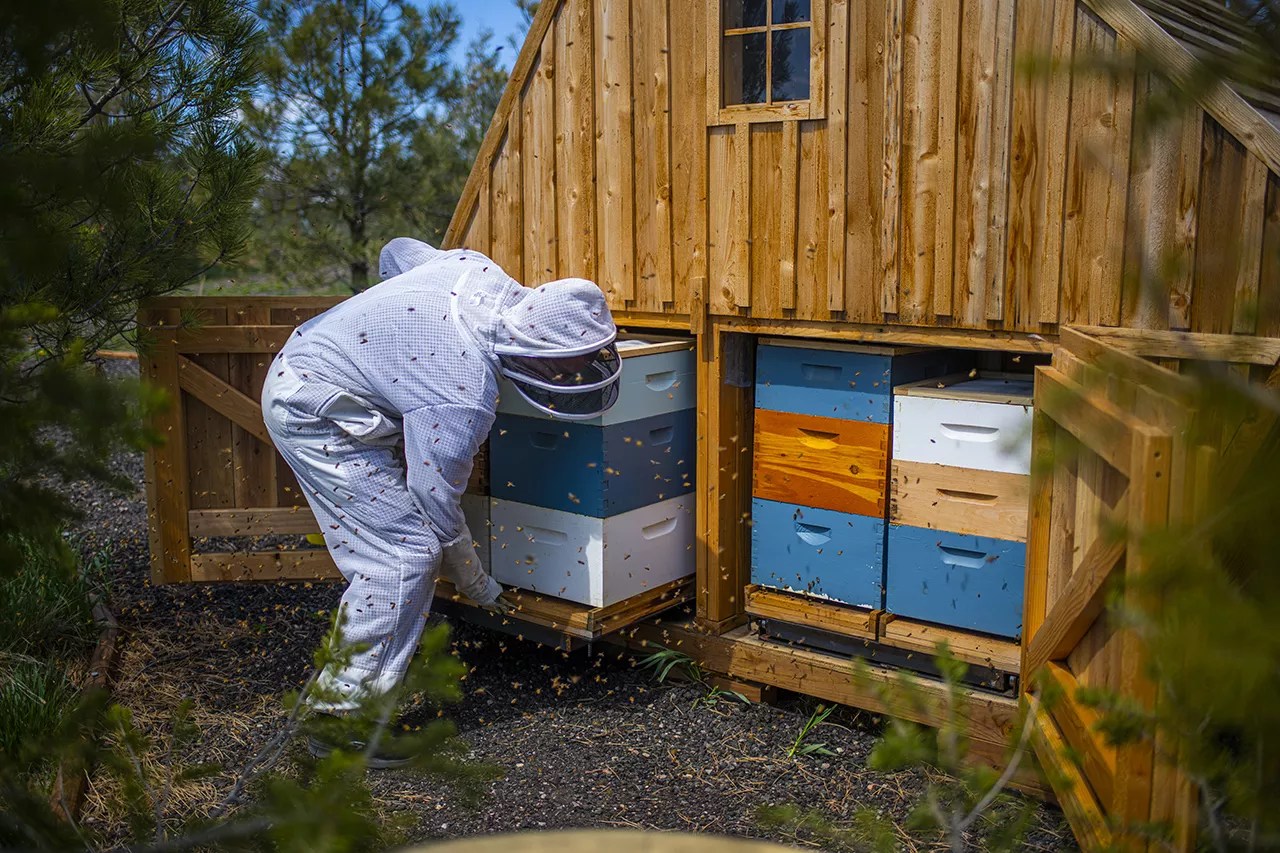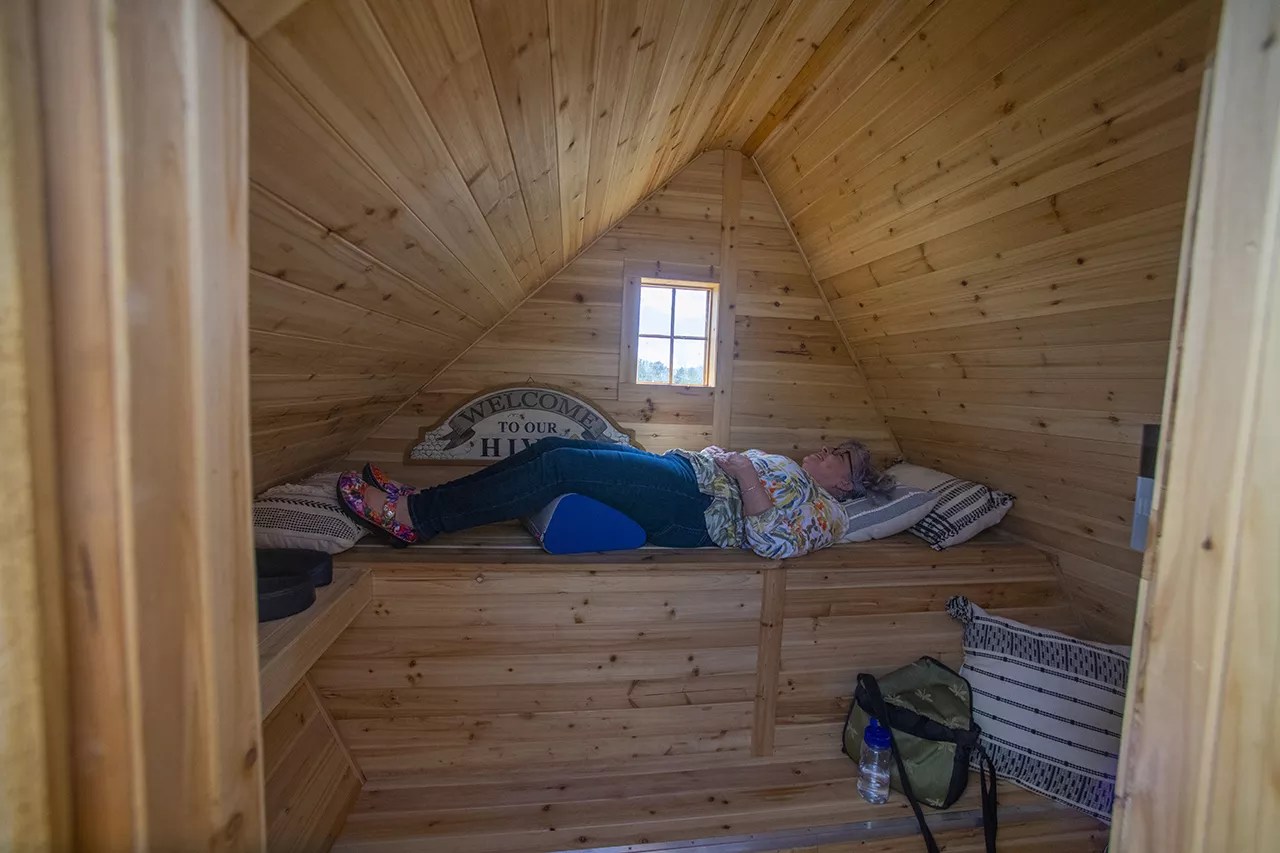
Evan Semón

Audio By Carbonatix
As she stepped into a bee hut at Capella Ranch, Kristen Yarmey smelled cedar along with a light, unfamiliar odor, and listened to the mesmerizing buzzes, taps and clicks the bees made as they performed their tasks in four hives underneath the pentagon-shaped hut.
She laid down on a bench and took it all in. The buzz of the bees’ wings, the crackling as they worked away at the wax, and the vapors from the antioxidants and pollen in the hives combined to create a meditative experience.
“There’s a really pleasant warmth,” she says. “It’s that deep sense that all is well, that everything is going the way it should be, that the Earth is alive and that you are safe.”
Yarmey visited Capella Ranch last summer, during the inaugural period when the huts were open for six weeks and people had a chance to safely get up close and personal with the bees.
In countries like Germany and Slovenia, inhaling the aerosol created by bees in an apiary, or collection of beehives, is an authorized treatment for respiratory diseases. But in the United States, there are only three places that offer the experience: one in Georgia, one in Michigan, and this one in Lafayette at Capella Ranch, which just opened for its second season.
“I’m going to be out here all summer, talking to people and enjoying them and hearing their stories,” says Carolyn Peterson, matriarch of the Peterson family, which owns the ranch.”They’re going to come stressed out, and then they’re going to leave relaxed.”

Carolyn and Charlie Peterson at Capella Ranch.
Evan Semón
The Petersons’ journey to opening an apiary began seven years ago, when they were living in Superior and adopted a dog named Olive from 4 Paws 4 Life Rescue and Boarding, adding to a household that already had two dogs. Then 4 Paws 4 Life sent Carolyn’s husband, Charlie, an email asking if the family would be interested in fostering some dogs.
Charlie forwarded the email to Carolyn. The family already had an aquarium, and their two daughters had kept various hermit crabs, gerbils, hamsters and guinea pigs over the years. But in the planned community of Rock Creek, there just wasn’t room for many more animals that lived outside of tanks.
“Just sending this to you,” Charlie wrote. “But we’d have to have a ranch.”
On a whim, Carolyn pulled up Zillow and searched for four- or five-acre farms along the Front Range. “I came across this house that was eight bedrooms, seven baths for under a million dollars in Boulder County – which, like seven years or six years ago, was unheard of,” she recalls.
When her mother, who lives with the family, walked in, Carolyn closed the computer, not wanting to explain what she was up to. When she went back online, she found an email from Charlie with a link to the same property. “I called him up and asked him if he had spyware on my machine,” she says.
He didn’t.
He’d simply done a search similar to hers and found the same listing. They called their realtor, went out to see the property in Lafayette…and bought it. The former owners had built a barn there in the ’70s, where they kept a few horses and a cow. The Petersons added a new barn, a “Chicken Manor,” a goat jungle gym and a duck pond to what they named Capella Ranch.
Carolyn picked the name after reading in a book about birthdays that her major star is Capella. She was also in an a cappella group at the time, so the name fit.
The couple, their two now-adult daughters and Carolyn’s mother all pitch in at the ranch. Charlie says they’ve been surprised that people are often willing to volunteer, but there’s never a shortage of work to do.

Carolyn Peterson with the ranch’s goats.
Evan Semón
The Petersons are considering expanding their operations by turning the half of the house they don’t live in into “a great retreat for women who like to drink wine,” as Carolyn puts it. Not an Airbnb, but something similar.
In the meantime, the ranch’s non-human residential community has continued to grow over the past half-dozen years, mainly when Carolyn finds a new animal to take in while Charlie is away on business trips for his day job with Amazon Web Services.
“I accidentally come across things,” she says. “We went to a chicken swap because we didn’t realize that we had so many roosters, and we had to get rid of them. We went there with four roosters and came home with a goat.”
Another time, she was listing some chickens for sale on Craigslist, but instead of going to check on her own post, she accidentally ended up on a page offering four alpacas and a llama. The woolly creatures became Capella Ranch residents for several years but now live on Harley’s Haven Ranch, a larger property in Colorado Springs.
“They were interesting lawn ornaments, but we weren’t doing them justice,” Charlie says. “Now they’re down on ten acres and having fun, so much fun.”
The Petersons sold Harley’s some of their alpaca equipment but donated the animals.
Capella Ranch currently has sheep, Nigerian dwarf goats, Nubian goats, ducks, chickens, a few turkeys and, of course, a plethora of bees, the first of which arrived in 2018. Animals are there to stay at the no-kill farm, Charlie says – though he does apologize to the few bees he’s sure he’s accidentally squashed over the years.
“We’re from Superior,” Carolyn laughs. “We can’t pluck a chicken!”

Charlie inspects a beehive cover.
Evan Semón
Charlie had always been interested in beekeeping but never had the space to keep bees until the family moved to the ranch. He didn’t just start keeping bees, though: He became a swarm-catcher.
Bees swarm when they reproduce, forming large balls of activity that can look quite intimidating to onlookers. But swarm-catchers are trained to handle them.
“Trust me on this, you’ll never forget it,” Charlie says. “Every rescue presents its own challenge, sometimes dangerous, but there is nothing quite like the feeling of knowing you’ve secured the queen and the hive is safe.”
People who see a swarm can call 1-844-SPY-BEES (779-2337), the Colorado State Beekeepers Association swarm and structural removal hotline, and a local beekeeper will come help. If the sighting is near Lafayette, Charlie gets the call, then brings the bees back to Capella Ranch after he snags them.
He and daughter Cassie caught the ranch’s first swarm in July 2018, an unusually late date for a swarm. That season generally starts in late April, as the weather warms, and lasts through June.
“There should be a twelve-step program for the addiction of catching swarms,” Carolyn says. “When he got twenty-some-odd swarms on the property, it’s like, ‘We really need to do something else with this. Because this is cute, but….'”
Charlie agreed that they needed to do something with all the bees, but they didn’t see the honey business as viable: The scale is big and the margins are small.
“The thing that I just kept coming back to all the time is how amazing honeybees are,” Charlie recalls. “They’re so close to magic, and it’s just fascinating to watch. Everything about them has some beneficial piece or part.”
They were still searching for a way to showcase the wonders of bees when Charlie visited a Thornton bee supply store, Plan Bee. There he struck up a conversation with another customer who mentioned apitherapy, using bee products to improve health. Part of apitherapy is the air therapy found in bee huts.
“I brought that idea home to Carolyn,” Charlie says. “We thought, ‘We have found the idea.'”
Carolyn used her research powers to gather information about how huts work, finding examples online of covered wagon-like structures with beehives underneath and even systems that resemble tanning beds, where people slide in and have a case closed over their heads. She thought that would be too claustrophobic, though.
And then she found the Savannah Bee Company in Georgia, which has huts that look like “something out of Candy Land or a Hans Christian Andersen fairy tale,” as the business says on its website.
“I would love to see bee huts around the country and the world,” says Ted Dennard, founder and head beekeeper at the Savannah Bee Company. “At the end of the day, our mission is to save the bees and raise awareness about the wonder of the honeybee however we can.”

Charlie Peterson puts the healthiest hives in the ranch’s bee huts.
Evan Semón
The Petersons decided to go that route, building two cedar huts shaped like irregular pentagons. The cedar contributes to the aroma in the huts, though Charlie says it was selected for durability in the Colorado weather. Another Carolyn Craigslist find contributed to the huts’ unique shape: She discovered Joe McCartney, who lives in Hudson and builds saunas and sheds in that shape. McCartney created customized structures that include a spot for the hives.
The slanted roof concentrates the aerosol so that people can breathe it in while they’re lying flat. “Everyone comes out with a different experience,” Carolyn says. “They get in there. They lie down. They take in the whole thing, and then they just sort of concentrate on the humming of the bees.”
When bees make honey, Charlie explains, there’s a lot of water in it at first, so the insects work to reduce the moisture content by flapping their wings. As it evaporates, the moisture is carried into the air to form an aerosol that people find therapeutic.
The bees also create an electromagnetic field with their vibration, which is at a frequency that’s calming to the human parasympathetic nervous system, a network of nerves that helps relax the body. Some people can feel the field, but most notice the smell first, Carolyn says. Underneath the scent of cedar, there is the aromatic tang of the bees at work, almost like the smell of a newborn baby, but with an extra oomph.
“That is all the pollen and propolis [made from the pollen of cone-bearing trees] and nectars and amino acids and essential oils that the bees are bringing in to make the honey,” Carolyn says. “It’s just kind of an odd smell, and that’s supposed to be very good to breathe in.”
In Slovenia, this bee experience has been used to calm firefighters after hard jobs, children who have behavioral problems at school, and parents of those children, who might need some relaxation after a stressful parent-teacher conference. The Petersons note that they aren’t medical professionals, so they don’t consider their huts medicinal.
“If it happens to help, great,” Carolyn says. “It’s relaxing. It’s thirty minutes of nobody bugging you.”

The buzzing of the bees creates a meditative experience inside the huts.
Evan Semón
One person who says the bee huts have helped is Marsha Ruggeri, who lives in Lafayette. She went to Capella Ranch four times during its inaugural season.
She first came with a friend who’d bought a deal on Groupon. After struggling with heightened asthma symptoms the past two years – which she attributes to wildfires and air pollution – Ruggeri was excited to learn of a potential way to alleviate her symptoms.
It worked.
“I’m not saying it was a panacea,” she says. “It felt like I was actually doing something that wasn’t an inhaler or medication and I was regaining some control over how my body was reacting to all this shit in the air.”
She’d had to cancel tennis games because of bad air quality three times last summer. After visiting the bee huts, she shared with other players that her asthma had improved because of the experience. Some of them also went to Capella Ranch to soak in the benefits.
Ruggeri bought honey made by the bees at Capella Ranch and found that helped, too. Although the Petersons aren’t technically in the honey business, the bees are so busy that the ranch does sell it, along with fresh chicken and duck eggs.
On Ruggeri’s third visit, she experienced the electromagnetic field produced by the bees.
“I was laying on my side, and then all of a sudden, I could feel it,” she says. “It really deserves more than one treatment. It’s kind of like people who go for acupuncture, and they’re like, ‘Well, it didn’t do anything for me.’ You really need to try it more than once.”
People often report feeling tingly, Carolyn notes. By design, the huts aren’t equipped with many cushions or other padding so that people can connect more closely with the bees.
“The first minute or two of just sitting on the bench may be kind of uncomfortable,” Charlie says. “But for me, by minute two or three, I’ve forgotten about it. We didn’t want to block any of the vapor, so that’s sort of the trade-off.”
Even beekeepers like Charlie can be lulled by their experiences in the huts; opening hives to do beekeeping work causes bees to get in a tizzy, but the humming sounds they create then are different from the noise they make when they don’t know someone is sitting in on their process.
“They don’t hear them like they normally hear them taking care of the hives,” he says. “Because you can’t help but interrupt them and send them airborne. That’s the nature of taking care of a hive.”
Along with the eight hives in the huts, there are six to eight more near a special pond on the ranch where the bees drink. Charlie puts the healthiest hives in his care in the huts. When he swaps them out, he uses hives he has stashed on other people’s properties; otherwise, bees might go back to the location of their previous hive, recognizing the landmarks in the area.
The Petersons have heard from people in Virginia and Seattle interested in opening their own bee huts; they hope more join the movement.
Last summer, over a hundred people came to Capella Ranch to check out the bees; a TikTok Charlie made announcing that the huts were open has gained about 20,000 views.
Yarmey, a yoga teacher and reiki practitioner from Fort Collins, was one of those visitors. She found Capella Ranch while scrolling on Instagram after reading a book about a female beekeeper and becoming curious about bees. “I’m really interested in energy and grounding and our connection to nature,” she says. Reiki is a practice of directing energy to help facilitate healing.

The cedar bee huts at Capella Ranch.
Evan Semón
After her first visit, Yarmey came back a second time, when she says she was really able to share a meditative space with the bees, reveling in their presence in a way that humans rarely get to do with other species.
“When else in your life do you get to share space with a million other beings who all are very clear about their purpose and their path and what they need to be doing?” she says. “Carolyn and Charlie are just such wonderful people. … It was just so lovely to spend time on their land. Everything felt a little slower, more grounded.”
The huts are now open for a second season; anyone is welcome except those allergic to bee or wasp stings. A thirty-minute session is $35; an hour runs $60. And on a first visit, anyone can book a complimentary fifteen-minute session with the Petersons to ask questions.
“It’s amazing how many people seem to be finding us,” Charlie says. “It sort of drives our belief that things that are supposed to be connected seem to connect, and that’s pretty cool. This was not a huge, lifelong dream of ours or anything.”
“We just thought, ‘Sounds fun,'” Carolyn adds. “We didn’t know what we were getting ourselves into, but it’s an adventure.”